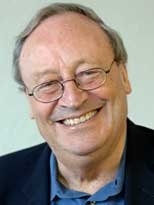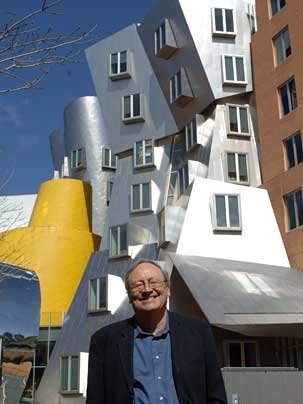Early explorations of what would eventually become the Ray and Maria Stata Center included crumpled pieces of paper, piles of toy-like wood and plexiglass blocks and something resembling a mass of discarded tin foil.
These were not designs, exactly, but provocative attempts by architect Frank Gehry to get his diverse group of MIT clients and the future inhabitants of the building to start to think about what they really wanted--to react, directly and emotionally, to the propositions on the table before them.
The stories behind the conceptualization, design and construction of the Stata Center and four other major buildings--Kevin Roche's Zesiger Sports and Fitness Center, Steven Holl's Simmons Hall, Charles Correa's Brain and Cognitive Sciences Complex and Fumihiko Maki's new project for the Media Laboratory--are contained in William J. Mitchell's new book "Imagining MIT: Designing a Campus for the Twenty-First Century."
Mitchell, former dean of the MIT School of Architecture, is the Alexander W. Dreyfoos Professor of Architecture and Media Arts and Sciences and director of the Smart Cities research group at MIT's Media Lab. Mitchell, who was heavily involved in all the building projects, said he wanted to show "how ideas evolved and changed" by providing a rare insider's glimpse of the process of creating iconic new campus spaces.
Published by MIT Press, the 142-page volume is a "new kind of architecture book," Mitchell said, which relates the good without shying away from the bad and the ugly. The book, which Mitchell first drafted in one long weekend at a Dublin hotel, is filled with images and anecdotes that reflect the complex and often surprising process through which the new buildings came to be. "The behind-the-scenes story about how architecture gets done--a rarely told story, a hard-to-tell story--needed to be written," Mitchell said.
Architecture is not "sitting down in a room and dreaming things up," he said. "There's money involved, and politics, and incredibly complex social forces and endless negotiation, and you have to try to make great buildings out of all that."
Mitchell, by including pictures of designs at different stages of the projects, wanted to show "how ideas evolved and how they changed. Large organizations such as universities are fundamentally conservative and want to minimize risk, so adventurous, innovative design for them takes both imagination and flexibility. Promising ideas had to be abandoned for practical reasons." The result is a book that appeals to an audience that includes the general public as well as urban designers and architects.
Stata was a particularly challenging project because Frank Gehry's extraordinary Guggenheim Museum in Bilbao, Spain, had projected him into "rock star fame," Mitchell wrote. Everyone had an opinion about him. Mitchell, meanwhile, was very aware of Gehry's professionalism: his attention to detail, his responsiveness to his client's day-to-day needs, his ability to keep costs in check. "Some people thought because he did radical things that he must be a crazy man," Mitchell said. "But he's a highly experienced, extremely skilled architect. And I knew the match to MIT would be fantastic." It was Mitchell who managed to keep Gehry's name in play for the project and helped mediate the ongoing, sometimes contentious discussions.
The process did generate more than a few infuriated e-mails when Gehry at one point suggested that the interior space mimic an "orangutan village." But in the end, the ensuing discussion led to a pivotal organization scheme for research groups within the building. And the Stata Center did not, Mitchell attested, come in absurdly over budget. "On a dollars-per-square-foot basis, it came out to no more than the median for comparable buildings constructed in the United States at roughly the same time," he wrote.
"Over the last few decades, MIT had been playing it very safe with its buildings," Mitchell said. "This was setting the bar of ambition much higher." Mitchell credited former MIT President Charles M. Vest with the "courage" to commit to the project. Vest did have his doubts, but, he wrote in an afterward to "Imagining MIT," after Gehry spent most of their first phone call telling stories about physicist Richard Feynman, "I hung up feeling great confidence that we would get what we wanted and needed."
A version of this article appeared in MIT Tech Talk on May 2, 2007 (download PDF).








